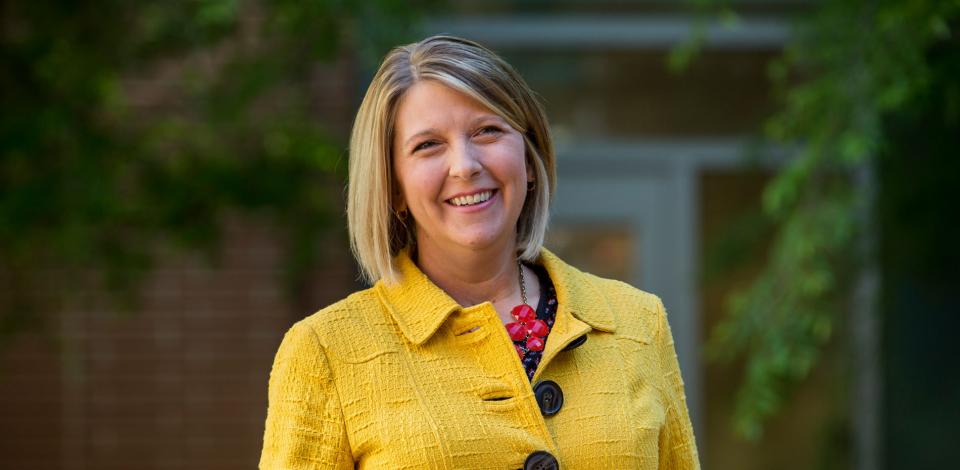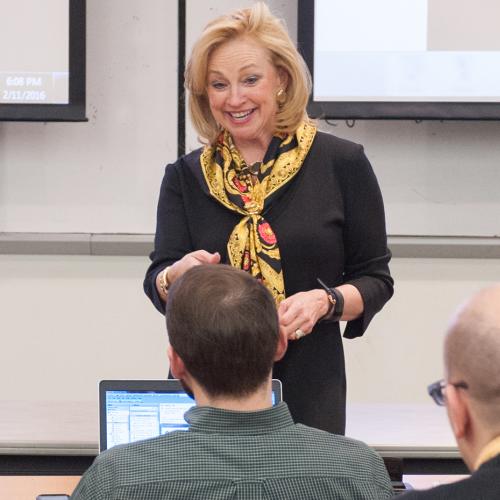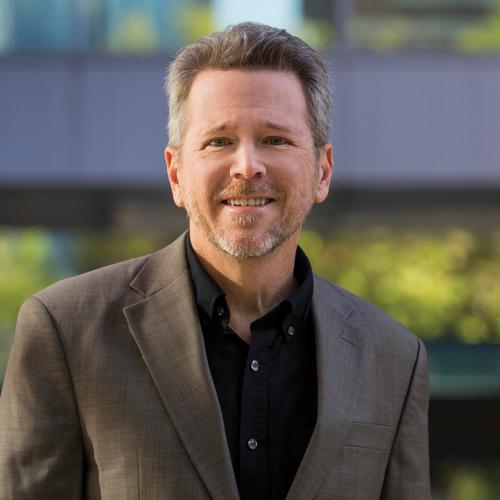Safety First: Innovation and Outreach in the OSHA Training Institute
Hilarie Warren wears many hats, and some are even protective

Hilarie Warren, director of the Georgia Tech OSHA Training Institute Education Center (OTIEC)
Written by Deirdra Harris Glover | Photography by Dane Sponberg
As a consultant for the Enterprise Innovation Institute (EI2) at Georgia Tech, Warren uses her background in public health and expertise in industrial hygiene to perform occupational health evaluations for Georgia businesses. Warren then brings this experience directly into Georgia Tech Professional Education’s classrooms as an instructor at the OSHA (Occupational Safety and Health Administration) Training Institute.
The Occupational Safety and Health Consultation Program at EI2 provides free and confidential on site assessments to small and medium-sized Georgia businesses. The nationwide program is funded through the Department of Labor, and helps companies identify and reach their OSHA compliance goals without enforcement action.
“I entered public health because I love science, but I equally love finding solutions for people that work for them and their business while providing the best protection possible for employees. I like looking upstream, which is the basic premise of public health: trying to focus on the preventative activities before they cause illness or injury. Intuitively, I know that’s the place we find the biggest bang for our buck,” said Warren.
Warren got her start in teaching back in 2005, when an opportunity arose to help lead OSHA 521 (Introduction to Industrial Hygiene) workshops. Warren proved to be a popular instructor, quickly transitioning from a workshop assistant to a lecturer and finally a course director for other OSHA Compliance classes. “It’s happened over time and through building my own experience, taking our own OTI classes and learning from some premier instructors that these opportunities facilitate my own classroom discussions have arisen. I’m grateful they have, because I really enjoy being in the classroom with our participants,” she said.
Warren finds that the classroom informs her consultancy and her research. A significant health hazard in the construction industry, especially in the southern U.S., is heat exposure and dehydration. The topic came up in many of Warren’s OTI classes and it influenced the faculty’s thoughts and research design.
“We talk a lot about the need for acclimation to hot environments and acclimatization as an important strategy to protect people. It’s a big deal when you’ve got people hiring from a temporary staffing provider, for example, or employees who’ve been out on leave or vacation. Those folks might not have been previously working in a hot, humid environment and then suddenly they’re out in these elements, and expected to work hard. It puts them at significant risk, and quickly. It’s something we have to address prior to the summer months,” said Warren.
In 2015, she received funds from the Georgia Tech Research Institute to study heat illness prevention and hydration strategies on a large high profile construction site, creating valuable materials for the client, as well as research supporting OSHA's Heat Illness Prevention Campaign.
“I really love that overlap — of being able to have these applied activities for what we see and measure and observe in the field, and then being able to bring that to light in the classroom,” said Warren. “It expands safety and health from an OSHA standard in a book to real-world scenarios that resonate at the personal level.”
Health and safety aren’t just concerns for employers and seasoned employees: Warren would prefer it if teenagers had training in safety and health hazards and control strategies before their first day at a job, an internship, or even as they transition to a career or technical school. The OTI partners with schools to reach youth, as they are at a much higher risk than other demographics for on-the-job injury in the first few days or their first year.
“The objective is to provide some knowledge to them on the front side so they understand what their rights are as an employee, what kinds of questions they should ask, and making sure they know they are protected by the law if they bring up a safety and health concern to their employer, she said. “When our team first started this type of outreach, my own personal realization was that I don’t think anyone talked to me about OSHA until I was in graduate school, and that was seven jobs in! That’s our goal with this curriculum and outreach: to heighten awareness with employers and youth.”
As science and technology education enjoys a recent emphasis in funding and focus, more people are training in general public health and safety engineering fields. “Historically, industrial hygiene was considered to be a very technical field, and it was predominantly male dominated, but we’re seeing a bit of a change in that for this new generation coming in,” Warren said.
“Once people are introduced to the field, they can see it as an opportunity to exercise scientific evaluation, while simultaneously getting their hands dirty, and also interfacing with people. I think that’s appealing to a lot of folks when there’s this blending of both soft and more technologically related skills. I think we’re seeing some growth in bringing women into this particular profession and certainly I’ve got some amazing female mentors who work in safety and health,” said Warren.
“Watching these individuals out there in the field navigating predominately male-dominated industries like construction management and business and research has been an essential part of my own career development. These women are strong voices for change and advocates for front-line employees, but they can also listen and respond to the business needs of a company, so ultimately, their work makes a tremendous difference. I hope I can be that kind of mentor for someone just starting out in this field, too.”
While the field requires technical and academic rigor, Warren finds a deep love for the human aspect of the work. “At the end of the day for those of us in the Professional Education group at the OSHA Training Institute there is a common theme of wanting to help people do better, live better, and take care of each other, both as individuals and as businesses. All of our instructors follow different pathways and share different stories to achieve this goal but I love that that’s the common thread weaving us all together. This shared passion, it brings people to our classes and while they might not expect it when they arrive, I know they sense it and are a part of it by the time they leave,” she said. “That’s safety: we all play a role in looking out for each other.”

